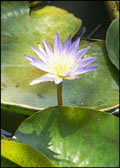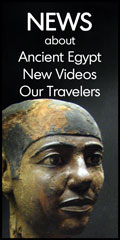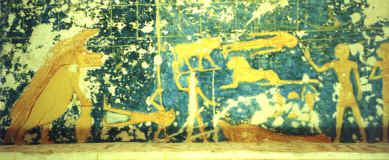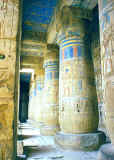|
"Egyptologists'
Egypt" 15-day
Egypt Tour beginning in Cairo: Sunday, Sept 11 - Sunday, Sept 25, 2005 This is a
Specially Designed Tour* |
|
CLICK
all pictures to ENLARGE.
Use BACK
arrow to return to
page. Sat.,
Sept 10, 2005: For
those beginning their tour in New York, USA, your plane leaves NY City,
at 6:30 PM, Saturday, September 10, 2005. You fly direct non-stop
from New York city, USA to Cairo, Egypt. You arrive the next day
at 11:30 AM. Other departure cities in the USA are available as
add-on's. Contact Us for
pricing.
We spend time inside the Red Pyramid (nearly as large as Giza's Great Pyramid) and then have the opportunity for an unforgettable walk across the open desert to the Bent Pyramid. The Bent pyramid is the only pyramid to retain most of its original casing stones. The Black Pyramid (Middle Kingdom mudbrick) can also be seen from here.
Our last site for today is the remains of Memphis, the "City of the White Wall," capitol of Egypt during the Old Kingdom. Optional:
Sound & Light Show at the Giza pyramids in the evening. Cost: $15-20 pp
We
are applying for a special government issued permit that will grant us a private
entrance to the Great Pyramid (for just our group and with all 3
chambers open to us) and a visit inside the Great Sphinx enclosure.
We have every reason to believe that we will receive this permission, as
we have on our previous tours. However, we cannot guarantee this
because government policies can change unexpectedly.
On the way home we will stop for shopping
at the famous Khan el Khalili
bazaar, if people would like. Day 6 - Fri, Sept 16: We leave early this morning and travel south via our own private A/C bus to Middle Egypt. At this time only about 15 people a week visit the sites in Middle Egypt (not like the thousands that visit Giza each day), so this is quite an opportunity. We begin with a visit to the Pyramid at Meidum. As we get our first look at it from a distance, this pyramid is strangely beautiful, even though it is not in good condition. Inside, we can touch some of the wooden timbers used in its construction more than 4,000 years ago! This is also the area where the famous statues (on display in the Cairo museum) of Rahotep and his wife were found, as well as the famous "Geese of Meidum". Traveling further south, we visit the tombs at Beni Hasan, a Middle Kingdom (2040 - 1640 BC) site. The nobles' tombs portray scenes from the daily life, and are well preserved, full of color and quite fascinating. Acrobatics, dancing, and military sports are emphasized. But there are also scenes of making flour, baking bread, weaving cloth, and even a husband and wife on their wedding night! There are many animals portrayed - both those that were domesticated and those that were hunted. There are also a few "mystic" beasts to speculate about, a unicorn... or what do you think? It
is near Beni Hasan that we find another interesting site, the "Speos
Artemidos," a rock cut temple for Pakhet, an aspect of the
lioness goddess Sekhmet. It is here that the female pharaoh,
Hatshepsut, made her declaration denouncing the Hyksos and telling of her
mission to resuscitate the temples of Egypt. Day 7 - Sat, Sept 17: This morning we visit the site of Tel-Amarna, a city built by Akhenaten and Nefertiti during the New Kingdom. We visit some nobles tombs with wall reliefs unequalled anywhere else in Egypt. The pictures appear alive and even as though they are moving. We also visit the Northern Palace, one of the markers of the city limits (a huge stone with hieroglyphics), the Southern Palace and the tomb built for Akhenaten. In
the afternoon we visit el-Ashmunein (Arabic), Hermopolis
(Greek), Khmunu (Ancient Egyptian) or the "City of the
Eight". It was the main cult center of Thoth (Djhueti,
Tehuti), god of Wisdom and writing, patron of scribes. We also visit Tuna
el-Gebel which was the neocropolis of Khmunu. All in all,
a very exciting day.
We
also may be able to explore the rarely visited Ramesses II Temple,
located a short distance from the Seti I Temple.
Day 10 - Tues, Sept 20: Optional early morning balloon ride over Luxor's West Bank. You decide about this option while you are in Egypt, a few days before arriving in Luxor. Cost: about $140 USD. Today we begin our touring of the West Bank of Luxor, one of the most famous archeological sites in the world. We start with the Valley of the Kings (optional: King Tut’s tomb, $12 USD). There are many tombs here, and excavations are still going on, as well as renovations to tombs that have been uncovered a long time. One never knows which tombs will be open, but there will be a variety to choose from.
We
will be spending the next two nights at a guest house on the
West Bank, so there is time for an evening
visit to one of the local alabastor shops, if you would like. From the veranda
of our guest house we overlook the Medinet Habu temple
and the West Bank hills. Day 11 - Wed, Sept 21: Tombs, tombs and more tombs! Today we see many in our visits to the Valley of the Nobles, the Valley of the Queens and the Valley of the Workmen. The Valley of the Nobles is known for the tombs where only the eyes were outlined in black. The most famous tomb in the Valley of the Queens, Nefertari's, is now closed. But there are some other ones that are now open. Deir El Medina, the "Valley of the Workmen," was called the "Valley of Truth" in Ancient Egypt. This is where the artists that decorated the tombs in the Valley of the Kings lived. Their own tombs have colorful scenes from daily life in the New Kingdom. There is also a chapel here with the famous Judgment scene. In
the later afternoon we see the rarely visited Seti I Temple which
still contains some beautiful reliefs. We also see what
are now called the "Colossi of Memnon." They are
actually colossi of Amenhotep III. The Greeks, however, thought they
were statues of Memnon, the son of Eros.
Another wonderful site that is rarely visited is the Ramesseum. There is splendid hypostyle hall, an astrological ceiling and some excellent wall reliefs in good condition. This is also where we find the fallen statue that inspired a poem by Shelley.
Evening
visit to a gold shop, if you would like.
Also
at Karnak, we visit the fascinating Open Air Museum where we view
the Red Chapel of Hatshepsut and Tutmosis III (Karnak's original Holy of
Holies) and Senwosret's
White Chapel with its finely-carved Middle Kingdom hieroglyphs.
These are in raised relief - some of the best to be found anywhere.
There is something new each time we visit, as reconstruction of new pieces
is ongoing. Time
for last minute shopping in Luxor. Maybe a visit to Aboudy's
Book Shop? Day
14 - Sat, Sept 24:
Return flight to Cairo where we have our second visit to the Cairo
Egyptian museum. Another option, if you prefer, is to visit
Old Cairo to see the Coptic churches there , or you can
head straight for the bazaar for shopping at the Khan El Khalili bazaar. Our
farewell
dinner is here in the old bazaar at the historic Naguib Mafouz
restaurant. Day 15 - Sun, Sept 25: Return flights home. For those leaving for the USA, your flight leaves at 10 AM and arrives in New York at 3:15 PM - the same day but with an increase of 7 hours for the time difference between Cairo and New York. For those traveling to the UK the time difference is 2 hours. There
may be changes to this itinerary due to circumstances beyond our
control. |
|
Prices What is Included in the "Egyptologist's Egypt" Tour Included: |
Photo credits this page: all photos by Ruth Shilling, except the Sun Temple altar (A1W traveler, Ken Reynolds).





















